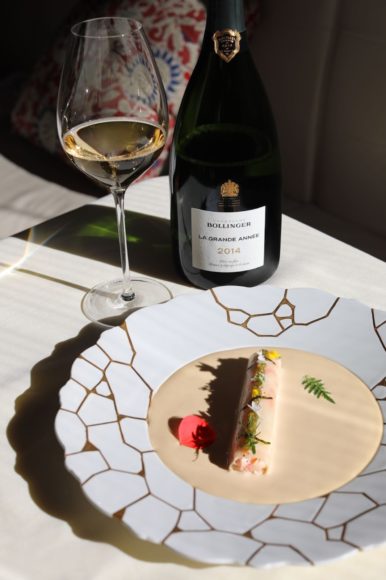Greatness in any field — be it athletic, artistic, culinary or oenological — requires patience. Sometimes that patience is thrust on us by world events.
As with other industries, the wine business’ public relations outreach has been crushed by the pandemic and is only now starting to regain its footing. Recently, I received an invitation for the release of Champagne Bollinger’s La Grande Année from 2014 at Chef Gabriel Kreuther’s midtown Alsatian restaurant. The Champagne and food pairing was still days away and I got giddy with anticipation. Patience. At the restaurant, we were greeted with a glass of Bollinger’s special Cuvée, a blend of wines assembled to show the house style. This Champagne was aged for twice the amount of time as the appellation requires. Patience.
Champagne Bollinger began in 1829 and is still owned by the original family. This in itself is rare in today’s Champagne world. Champagne houses are bought up, merged and changed so that even if the original name is still there, often the original family, the inspiration, is gone. Through the generations, the principals of the Bollinger family have come to realize excellence in the industry requires owning the land and the vineyards and bought up nearby properties as they became available. Today Bollinger owns 179 hectares (442 acres) of planted vines and controls its wine production from the budding of the vines to that “pop” at the table.
In the Champagne region, east of Paris, the many Champagne houses all make wine every year, sometimes blending multiple vintages for their unique signature flavor. But when all the meteorological influences fall into place to create the perfect growing season from bud break through harvest, a house will declare a vintage year. And it is not usually a vintage year throughout the entire region because of micro climatic differences affecting different plots. The 2014 vintage was just such a perfect growing season for Bollinger — one we recalled as we tasted the just- released vintage 2014 La Grande Année, precisely paired with a multicourse meal at Restaurant Gabriel Kreuther.
Bollinger ferments its juice into wine in used oak barrels that impart some flavor and mouthfeel. The porosity of the wood, as opposed to stainless steel tanks, provides some micro-oxygenation that significantly improves the Champagne’s ability to age. Bollinger also employs its own in-house cooper, who makes the oak barrels, the only Champagne house to do so. But that’s just the beginning. Riddling in Champagne is the process by which the bottles are placed in racks and twisted and positioned more vertical over time, neck down, until all the sediment collects near the cork. Disgorgement is the process of freezing the neck of the bottle so that pulling the cork and the pressure in the bottle expels the frozen plug of dead yeast. These time-consuming required tasks are done entirely by hand.
Bollinger’s deputy Chef du Cave Denis Bunner told us, “We make the wine first and bubbles second. We need that unique and legendary taste and then we add the Champagne bubbles. The year 2014 was perfect for the grapes — a slow-ripening season, no hail or damaging storms. The wine shows good minerality from the soil contribution — acidity, freshness, salinity, creaminess.” Chef Kreuther then told us, “There are layers to wine. There are layers to this meal. These Champagnes were made for food. Savor each by a bite, a sip, a bite and a sip.”
The 2014 La Grande Année is nothing short of outstanding. At 61% Pinot Noir and 39% Chardonnay, the majority of the wine is derived from Bollinger’s finest Grand Cru vineyards. Each sip showed a fresh, lively citrus with hints of peach and nuttiness. Each taste seemed to accent a different flavor in its profile. We next tasted the same wine from a magnum bottle, twice the size as the first. Magnums age wines at a slower, different pace. The wine clearly had the same DNA flavors, but it was more lemony fresh, vibrant and youthful.
Our next course was paired with the 2014 La Grande Année Rosé, comprised of a touch more Pinot Noir and a touch less Chardonnay, to which 5% red wine from a special parcel in the town of Aÿ was added. This wine presented brilliant peachy and stone fruit flavors along with citrus, grapefruit, strawberry and cherry.
Chef Kreuther paired our first La Grande Année with an Alaskan king crab “cannelloni” supported with sea urchin coulis, Osetra caviar and a Parmesan crisp. His slightly simplified “homecook version” is here to allow for something similar to our “in-house” tasting. Look for the Bollinger. Find Chef Kreuther’s ingredients. And start to build something brilliant in your kitchen. Start with patience.
Alaskan King Crab ‘Cannelloni’ With Sea Urchin Coulis
“Imagine taking a cruise and going on a quest of flavors.” — Gabriel Kreuther
For the cannelloni dough
Ingredients:
- 4 cups all-purpose flour
- 1 teaspoon salt
- 1 cup boiling water
- 1 teaspoon white vinegar
- Grapeseed oil, for brushing the pasta
Directions:
- Put the flour and salt in a food processor. With the machine running, add the boiling water and vinegar and run until the dough is mealy, a few seconds, and can be worked by hand to turn it into a smooth dough. Knead the dough until it can be shaped into a disc. Wrap it in plastic and refrigerate it for 20 minutes or so.
- Roll the dough through a pasta roller many times on the widest setting, folding it in thirds each time until it is smooth and elastic. Roll it out in successively narrower settings until the second-to-last or last setting. It should be thin and translucent.
- Cut the dough into a dozen 4 and 1/2-inch squares.
- In a large pot of boiling, salted water, cook the pasta, about a minute or so, then remove it to an ice bath.
- Lay the squares out on a sheet of oiled parchment paper, brushing them gently with oil to prevent them from sticking.
For the sea urchin coulis
Ingredients:
- 3 tablespoons vermouth
- ½ cup water
- 1/4 teaspoon cayenne pepper
- 1 teaspoon salt
- 6 ounces sea urchin roe
- 3 tablespoons grapeseed oil
- 1/2 tablespoon lemon juice
Directions:
Put the vermouth in a pot, bring it to a simmer and reduce it by one-third, then add the water, cayenne and salt. Remove the pan from the heat and add the sea urchin roe, stirring to cook it slightly. Transfer the mixture to a blender and blend until the coulis is frothy. Mix in the grapeseed oil. Strain it into a bowl, then set it in ice to chill it. Add the lemon juice.
For the crab mixture
Ingredients:
- 10 ounces king crabmeat, roughly chopped
- 3 tablespoons grapeseed oil
- Lemon juice
- Salt and freshly ground black pepper
- 1/8 teaspoon cayenne or Aleppo pepper
Directions:
Mix the crabmeat with the grapeseed oil to coat, then season with lemon juice. Taste and season with salt, black pepper and cayenne.
For the garnish (optional)
Ingredients:
- 1 piece of nori seaweed, 2/3 inch in length, julienned
- 2 ounces Osetra caviar
- Chopped chives
- Seasonal baby herbs and flowers
- Aleppo pepper
To assemble the dish
Directions:
Place about 3 teaspoons of crab filling along one edge of a pasta square. Roll the dough around the crab so that you have a full cylinder of crab, just until the pasta comes together. (It should stick to itself.) Trim excess pasta. Repeat with the remaining pasta squares. Froth the coulis with a hand blender and divide the coulis among six plates. Place one cannelloni on top of each plate. Garnish as desired and serve immediately. Serves 6.
Write me at doug@dougpaulding.com.


